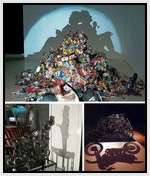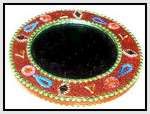|
Lifestyle -
Arts and Culture
|
|
Written by Administrator
|
|
 November 15th is “America Recycles Day,” and what could be a more inspiring way to reduce waste in your household than to encourage your children to recycle trash materials and objects into art? November 15th is “America Recycles Day,” and what could be a more inspiring way to reduce waste in your household than to encourage your children to recycle trash materials and objects into art?
Plenty of modern and contemporary artists use unusual materials and objects in their art creations. You’ll find all kinds of scrap materials and useful objects that can be reused in art projects, if you look around your house. Junk mail, kitchen containers, scraps of gift-wrap or wallpaper, old magazines, and all kinds of other objects will come in useful.
Artist’s Principles.: As an artist, your materials should be treated with respect. Save scrap materials in large boxes, making sure they are clean and dry before storing. In the same way that you would respect and value materials that you bought from an art store, you should value the scrap materials and trash objects that you are going to incorporate into your art.
When you work with any materials, including trash, keep your art creativity environment clean and tidy. Wash your tools when needed, and have a good supply of paper towels for cleaning up as you work.
Creativity can be just as much about discovering new and different ways to use and incorporate novel materials into your art as about the end result. Encourage your child to enjoy the process of making his or her artistic creations. There is no “right” or “wrong” way to make art, and while your child may enjoy following instructions in order to create something designed by someone else, encourage out-of-the-box thinking and teach your child to value his own ideas as much as any ideas he finds in a book or on a website...
|
|
Lifestyle -
Arts and Culture
|
|
Written by Administrator
|
|
 Have you ever seen a crazy cool mural that you can’t stop looking at? That is probably because murals are simply a skillful attempt at creating illusion. They can totally expand our horizons and often times they transport us to another time or place through images. In their simplest form, murals are simply decorative artistic renderings on a common wall or living space that is generally grand in scale. Certain materials are needed to complete a mural but painting easel is not one of them. Here are some truly interesting facts about the fantastic murals of our world. Have you ever seen a crazy cool mural that you can’t stop looking at? That is probably because murals are simply a skillful attempt at creating illusion. They can totally expand our horizons and often times they transport us to another time or place through images. In their simplest form, murals are simply decorative artistic renderings on a common wall or living space that is generally grand in scale. Certain materials are needed to complete a mural but painting easel is not one of them. Here are some truly interesting facts about the fantastic murals of our world.
1. Typically, murals are largely inspired by six main topics: religion, the four seasons (fall, winter, spring, and summer), historical events, ages of man, politics, and social issues...
|
|
Lifestyle -
Arts and Culture
|
|
Written by Administrator
|
|
 First archaeologically proved traces of Indian handicrafts belong to the Indus Valley civilization way back in 3000 B.C. During this time Indian craftsmen were doing excellent job in pottery making, bead making, terracotta, jewelry and weaving. The most significant aspect is the technical advancement in the handicrafts field at this time. The archaeologists have excavated many sites like Harappa, Mohenjodaro, Lothal, Chanhudaro, Kotdigy, Dholaveera etc. and they have found numerous artifacts that manifest the skill of the craftsmen at that time. First archaeologically proved traces of Indian handicrafts belong to the Indus Valley civilization way back in 3000 B.C. During this time Indian craftsmen were doing excellent job in pottery making, bead making, terracotta, jewelry and weaving. The most significant aspect is the technical advancement in the handicrafts field at this time. The archaeologists have excavated many sites like Harappa, Mohenjodaro, Lothal, Chanhudaro, Kotdigy, Dholaveera etc. and they have found numerous artifacts that manifest the skill of the craftsmen at that time.
In Vedic age (1500 B.C. to 700 B.C.) too a lot of advancement in handicrafts had taken place. There is reference of pottery making, weaving wood crafting etc in the Vedas. Rig Veda especially mentions about pottery made from clay, wood and metal. Weaving and weavers also find the reference in these holy texts. In the later Vedic period the principal development was the discovery of iron. This led to the manufacture of iron weapons on mass scale. Craftsmen got a huge exposure and the crafts traditions started to be entrenched in the social structure.
During Maurya period Indian handicrafts reached to perfection in certain art forms especially in stone crafts. After the great transformation of Ashoka from a hardcore imperialist to Buddhist reformist, numerous activities indulging the craftsmen began. It is said that not less than 84000 stupas were build during the reign of Ashoka. Most prominent stupas whose remains are still available are located at Sanchi, Bharhut, Vaishali, Amaravati and Mathura. Similarly the iron pillars of Delhi and Vaishali are the marvelous examples of metallurgy...
|
|
|
<< Start < Prev 21 22 23 24 25 26 Next > End >>
|
|
Page 22 of 26 |


 Dyscario Feed
Dyscario Feed